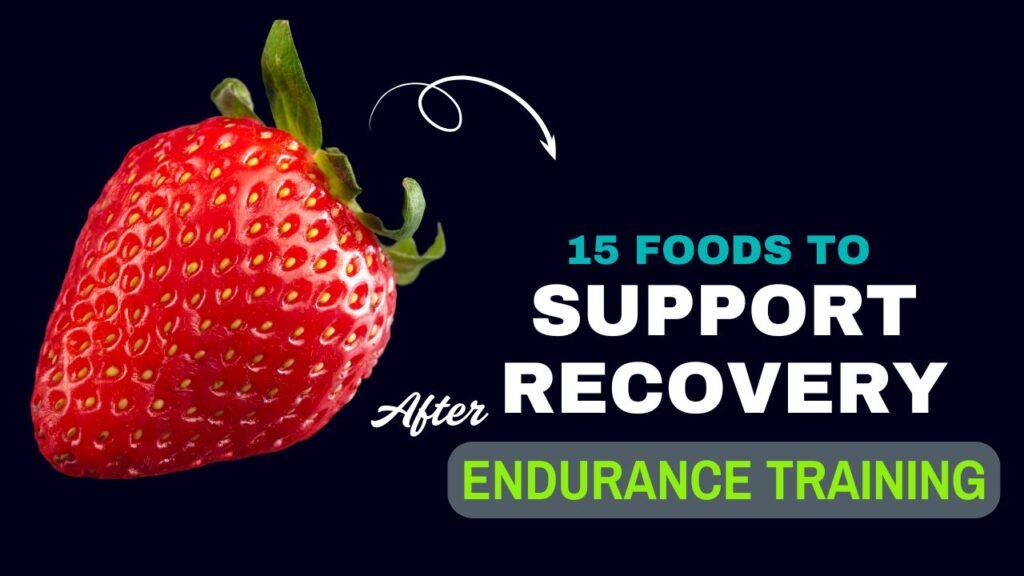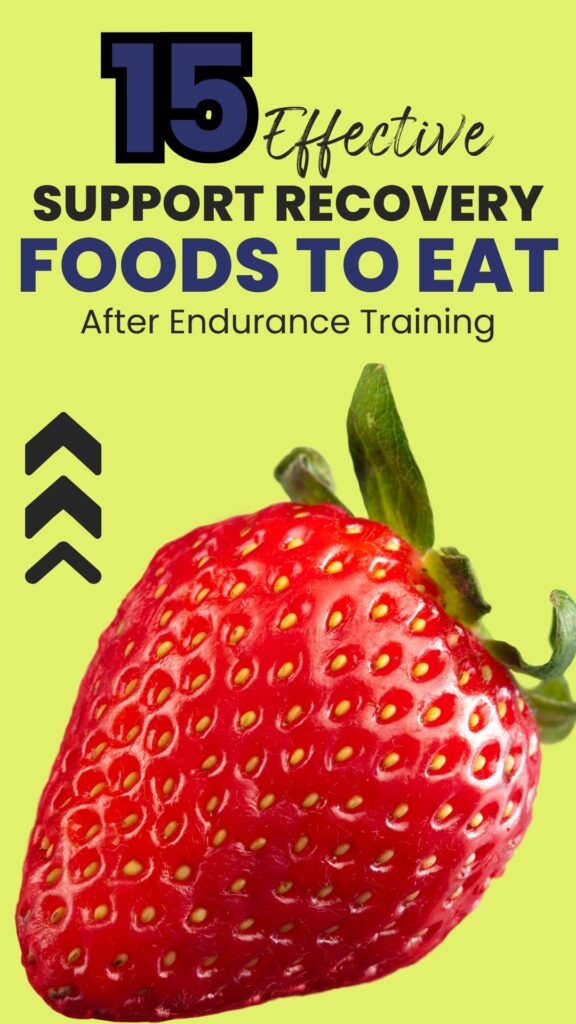Struggling with sore muscles, fatigue, or slow recovery after a long run or cycling session? You’re not alone. Endurance training pushes your body to its limits, depleting energy stores and breaking down muscle tissue.
The secret to bouncing back faster and performing better the next day isn’t just in your workout—it’s on your plate.
Did you know? Research shows that the right recovery foods can reduce muscle soreness by up to 30%, replenish glycogen levels, and even lower your risk of injury. Yet many athletes underestimate the power of nutrition after training.
In this post, we’ll cover 15 science-backed foods that can accelerate recovery, restore energy, and optimize your performance. For each food, you’ll learn:
- The best ways to eat or use it
- Who should include or avoid it
- Smart buying and storage tips
- Do’s & don’ts in a quick table format
- Possible side effects (if any)
Let’s dive in and build your ultimate post-endurance recovery menu.

Table of Contents

15 Best Foods To Support Recovery
1. Bananas
Bananas are nature’s instant energy booster, packed with simple carbs and potassium to restore electrolytes lost through sweat.
Best Ways to Eat or Use It
- Pre- or post-training snack on its own
- Blend into recovery smoothies with protein powder
- Slice over oatmeal or Greek yogurt
Who Should Eat / Avoid
- Good for: endurance athletes, runners, cyclists, and anyone prone to cramps
- Avoid if: you have high potassium levels (hyperkalemia) or are on kidney-related dietary restrictions
Storage & Buying Tips
- Choose bananas with a few brown spots for optimal sweetness.
- Store at room temperature, away from direct sunlight.
- To slow ripening, separate bananas from the bunch.
Do’s & Don’ts
| ✅ Do | ❌ Don’t |
|---|---|
| Eat ripe bananas for quick carbs | Store in the fridge before ripening |
| Pair with protein like nut butter | Depend only on bananas for recovery |
Possible Side Effects
- Overconsumption may lead to excess sugar intake.
2. Sweet Potatoes
Sweet potatoes are rich in complex carbs, beta-carotene, and antioxidants that replenish glycogen while reducing inflammation.
Best Ways to Eat or Use It
- Roast or steam and drizzle with olive oil
- Mash as a side dish with lean protein
- Bake sweet potato fries for a healthy snack
Who Should Eat / Avoid
- Good for: athletes needing long-lasting carbs
- Avoid if: you have blood sugar imbalances and need to monitor carb intake
Storage & Buying Tips
- Choose firm, unbruised sweet potatoes.
- Store in a cool, dark place—not in the fridge.
Do’s & Don’ts
| ✅ Do | ❌ Don’t |
|---|---|
| Pair with healthy fats to boost beta-carotene absorption | Store in the refrigerator (alters taste/texture) |
| Include in meal prep for training weeks | Eat deep-fried versions often |
Possible Side Effects
- May cause digestive discomfort if eaten in large amounts.
3. Salmon
A powerhouse of omega-3 fatty acids, salmon reduces post-exercise inflammation and supports muscle repair with high-quality protein.
Best Ways to Eat or Use It
- Grilled, baked, or steamed fillets
- Add to salads or wraps
- Smoked salmon with whole-grain crackers
Who Should Eat / Avoid
- Good for: athletes seeking faster recovery and joint health
- Avoid if: allergic to fish or on certain medications that interact with omega-3s
Storage & Buying Tips
- Opt for wild-caught salmon if possible.
- Store fresh salmon in the fridge and consume within 1–2 days.
Do’s & Don’ts
| ✅ Do | ❌ Don’t |
|---|---|
| Cook with minimal oil | Reheat multiple times |
| Freeze portions for later use | Leave unrefrigerated for long hours |
Possible Side Effects
- Excess intake can increase mercury exposure if not carefully sourced.
4. Greek Yogurt
Greek yogurt is packed with protein, calcium, and probiotics, making it ideal for repairing muscles and supporting gut health.
Best Ways to Eat or Use It
- Mix with berries and honey for a recovery snack
- Blend into smoothies
- Use as a base for savory dips
Who Should Eat / Avoid
- Good for: athletes, women needing calcium, and those building muscle
- Avoid if: lactose intolerant or allergic to dairy
Storage & Buying Tips
- Buy plain, unsweetened Greek yogurt.
- Store in the coldest part of the fridge.
Do’s & Don’ts
| ✅ Do | ❌ Don’t |
|---|---|
| Pair with fruits for antioxidants | Choose flavored versions loaded with sugar |
| Use as a substitute for sour cream | Leave open for days |
Possible Side Effects
- May cause bloating in lactose-sensitive individuals.
5. Berries (Blueberries, Strawberries, Raspberries)
Packed with antioxidants, berries help reduce oxidative stress from endurance training.
Best Ways to Eat or Use It
- Add to oatmeal or smoothies
- Mix with Greek yogurt
- Eat fresh as a snack
Who Should Eat / Avoid
- Good for: athletes, those fighting inflammation
- Avoid if: allergic to berries
Storage & Buying Tips
- Choose bright, firm berries without mold.
- Store in fridge and wash before eating.
Do’s & Don’ts
| ✅ Do | ❌ Don’t |
|---|---|
| Eat fresh for maximum antioxidants | Store washed berries (shortens shelf life) |
| Freeze for long-term storage | Leave exposed to air |
Possible Side Effects
- Too many berries may cause stomach upset due to fiber.
6. Eggs
Eggs deliver protein and essential amino acids for muscle repair.
Best Ways to Eat or Use It
- Boiled, scrambled, or poached
- Add to sandwiches or wraps
- Use in protein-rich salads
Who Should Eat / Avoid
- Good for: all athletes, especially strength-endurance mix
- Avoid if: high cholesterol issues (consult doctor)
Storage & Buying Tips
- Buy pasture-raised if possible.
- Store in fridge, pointed side down.
Do’s & Don’ts
| ✅ Do | ❌ Don’t |
|---|---|
| Eat whole eggs for complete nutrition | Eat raw eggs (risk of salmonella) |
| Combine with veggies | Store unrefrigerated |
Possible Side Effects
- Some may experience digestive discomfort or cholesterol concerns.
7. Quinoa
Quinoa is often called a “super grain,” but technically, it’s a seed. It’s gluten-free, high in protein, and provides all nine essential amino acids, making it a complete protein—rare for plant-based foods. It’s also rich in magnesium and iron, which endurance athletes often need more of.
Best Ways to Eat or Use It
- Use as a base for post-workout grain bowls with veggies and lean protein
- Mix into salads for added protein and texture
- Prepare as a warm breakfast porridge with fruit and nuts
Who Should Eat / Avoid
- Good for: vegetarians, vegans, athletes needing extra protein and iron
- Avoid if: sensitive to saponins (can rinse quinoa before cooking to reduce irritation)
Storage & Buying Tips
- Buy pre-rinsed quinoa to save time.
- Store dry quinoa in an airtight container in a cool, dark place.
- Cooked quinoa can last 4–5 days in the refrigerator.
Do’s & Don’ts
| ✅ Do | ❌ Don’t |
|---|---|
| Rinse before cooking to remove bitterness | Store cooked quinoa at room temperature |
| Pair with beans or vegetables for a balanced meal | Overcook (it becomes mushy) |
Possible Side Effects
- May cause mild bloating due to fiber content if consumed in large amounts.
8. Spinach
Spinach is a leafy green powerhouse, rich in iron, vitamin K, and antioxidants that fight inflammation and support red blood cell production—critical for endurance athletes.
Best Ways to Eat or Use It
- Toss fresh leaves into salads or smoothies
- Lightly sauté with garlic as a side dish
- Add to omelets or wraps
Who Should Eat / Avoid
- Good for: athletes needing iron, women with higher iron demands
- Avoid if: prone to kidney stones (oxalates may contribute)
Storage & Buying Tips
- Look for crisp, dark green leaves without yellowing.
- Store in the refrigerator in a breathable bag.
- Wash just before eating to avoid sogginess.
Do’s & Don’ts
| ✅ Do | ❌ Don’t |
|---|---|
| Pair with vitamin C-rich foods for better iron absorption | Overcook (destroys nutrients) |
| Use raw in smoothies for quick nutrition | Store wet leaves |
Possible Side Effects
- High oxalate content may increase risk of kidney stones in sensitive individuals.
9. Almonds
Almonds provide healthy fats, vitamin E, and magnesium—all crucial for muscle recovery and energy metabolism.
Best Ways to Eat or Use It
- Snack on raw or roasted almonds
- Blend into almond butter and spread on toast
- Sprinkle over oatmeal or salads
Who Should Eat / Avoid
- Good for: endurance athletes, those seeking healthy fats
- Avoid if: nut allergies or need to restrict calorie-dense foods
Storage & Buying Tips
- Buy raw or lightly roasted almonds without added salt.
- Store in an airtight container to prevent rancidity.
Do’s & Don’ts
| ✅ Do | ❌ Don’t |
|---|---|
| Eat a handful daily for healthy fats | Overconsume (calorie-dense) |
| Store in a cool place to avoid spoilage | Buy heavily salted/flavored versions |
Possible Side Effects
- Excess intake may cause weight gain due to high calorie density.
10. Oats
Oats are an excellent source of complex carbs, soluble fiber, and B vitamins, making them perfect for restoring energy and stabilizing blood sugar post-training.
Best Ways to Eat or Use It
- Classic oatmeal with fruit and nuts
- Overnight oats for a quick breakfast
- Blend into smoothies or protein shakes
Who Should Eat / Avoid
- Good for: athletes needing steady energy release
- Avoid if: gluten-sensitive (choose certified gluten-free oats)
Storage & Buying Tips
- Store oats in an airtight container.
- Choose rolled or steel-cut oats over instant for more fiber and nutrients.
Do’s & Don’ts
| ✅ Do | ❌ Don’t |
|---|---|
| Pair with protein for balanced recovery | Overload with sugar toppings |
| Use oats in baked snacks for pre/post workouts | Leave open (absorbs moisture) |
Possible Side Effects
- May cause bloating in sensitive individuals.
11. Turmeric
Known for its active compound curcumin, turmeric is a natural anti-inflammatory spice that supports muscle recovery and joint health.
Best Ways to Eat or Use It
- Add to curries, soups, or stews
- Stir into golden milk with warm milk and black pepper
- Blend into smoothies for an antioxidant boost
Who Should Eat / Avoid
- Good for: athletes with joint pain or inflammation
- Avoid if: you’re on blood thinners (consult a doctor)
Storage & Buying Tips
- Store turmeric powder in a cool, dry place.
- Fresh turmeric root should be kept in the fridge.
Do’s & Don’ts
| ✅ Do | ❌ Don’t |
|---|---|
| Combine with black pepper for better absorption | Overuse (can cause stomach upset) |
| Add to warm dishes for best flavor | Store in direct sunlight |
Possible Side Effects
- High doses may cause digestive discomfort.
12. Cottage Cheese
Cottage cheese is rich in casein protein, which digests slowly, providing muscles with a steady stream of amino acids overnight.
Best Ways to Eat or Use It
- Eat plain with fruit or honey
- Spread on whole-grain toast
- Mix into smoothies for extra creaminess
Who Should Eat / Avoid
- Good for: athletes, people looking for slow-release protein
- Avoid if: lactose intolerant or allergic to dairy
Storage & Buying Tips
- Buy low-fat or full-fat versions depending on dietary needs.
- Store in fridge and consume within a week of opening.
Do’s & Don’ts
| ✅ Do | ❌ Don’t |
|---|---|
| Eat before bedtime for overnight recovery | Leave unrefrigerated |
| Pair with fruit or nuts | Consume past expiration |
Possible Side Effects
- May cause bloating for those sensitive to dairy.
13. Chia Seeds
Tiny but mighty, chia seeds are rich in omega-3s, fiber, and antioxidants. They absorb water and form a gel, aiding hydration and digestion.
Best Ways to Eat or Use It
- Add to smoothies or oatmeal
- Make chia pudding with milk or yogurt
- Sprinkle over salads
Who Should Eat / Avoid
- Good for: endurance athletes needing hydration support
- Avoid if: sensitive to high fiber intake or have digestive issues
Storage & Buying Tips
- Store in airtight containers in a cool, dry place.
- Chia seeds last long due to their natural oils.
Do’s & Don’ts
| ✅ Do | ❌ Don’t |
|---|---|
| Soak before eating to improve digestibility | Eat large amounts dry (can swell in throat) |
| Use in recipes for extra fiber | Ignore portion sizes |
Possible Side Effects
- Too much fiber may cause bloating or stomach discomfort.
14. Chicken Breast
Lean chicken breast is a protein powerhouse, low in fat and ideal for repairing muscles after endurance workouts.
Best Ways to Eat or Use It
- Grilled, baked, or roasted with herbs
- Shredded into salads or wraps
- Added to soups and stir-fries
Who Should Eat / Avoid
- Good for: athletes needing lean protein
- Avoid if: vegetarian, vegan, or allergic to poultry
Storage & Buying Tips
- Buy fresh, firm chicken breast with no odor.
- Store raw chicken in fridge for 1–2 days or freeze immediately.
Do’s & Don’ts
| ✅ Do | ❌ Don’t |
|---|---|
| Cook thoroughly to avoid bacteria | Reuse marinade from raw chicken |
| Pair with complex carbs for recovery meals | Leave unrefrigerated |
Possible Side Effects
- Risk of foodborne illness if undercooked.
15. Dark Chocolate (70%+)
Dark chocolate isn’t just a treat—it’s packed with antioxidants, magnesium, and flavonoids that improve blood flow and reduce stress hormones after training.
Best Ways to Eat or Use It
- Eat a small square post-training
- Add shaved dark chocolate to oatmeal or yogurt
- Blend into smoothies for flavor and recovery benefits
Who Should Eat / Avoid
- Good for: athletes needing a morale-boosting, antioxidant-rich snack
- Avoid if: caffeine-sensitive or prone to migraines
Storage & Buying Tips
- Choose chocolate with at least 70% cocoa content.
- Store in a cool, dry place away from sunlight.
Do’s & Don’ts
| ✅ Do | ❌ Don’t |
|---|---|
| Eat in moderation (1–2 squares) | Overconsume (high in calories) |
| Use as a healthy dessert option | Choose milk chocolate (less nutrients) |
Possible Side Effects
- Overeating may cause caffeine-related jitters or weight gain.
Conclusion
The road to peak endurance performance isn’t just paved with miles of running or cycling—it’s also built on smart nutrition choices. These 15 foods, from quick energy boosters like bananas to anti-inflammatory heroes like salmon and turmeric, give your body the nutrients it craves for faster recovery.
By combining protein, complex carbs, healthy fats, and antioxidants, you’ll not only shorten recovery time but also enhance strength, reduce soreness, and fuel your next training session more effectively.
Next time you lace up for a long run or ride, remember: what you eat after is just as important as the training itself. Start small by adding one or two of these foods into your recovery meals, and notice the difference in how you feel.
Which recovery food will you try first? Share your go-to meal in the comments below!
Frequently Asked Questions (FAQs)
What should I eat immediately after endurance training?
Within 30–60 minutes, aim for a mix of carbs and protein. Examples include a banana with Greek yogurt, oatmeal with berries, or grilled chicken with sweet potato.
How much protein do I need after endurance training?
Most athletes benefit from 15–25 grams of protein post-training to support muscle repair. This could be two boiled eggs, a cup of Greek yogurt, or a salmon fillet.
Can I use supplements instead of recovery foods?
While supplements like protein shakes can be convenient, whole foods provide additional nutrients such as antioxidants, vitamins, and minerals that aid recovery.
Do I need to eat even if I’m not hungry after a workout?
Yes. Intense endurance training depletes glycogen and damages muscle fibers. Even a small snack can kickstart recovery and prevent energy crashes.
What foods should I avoid after endurance training?
Avoid heavily processed foods, fried meals, and sugary snacks—they slow recovery, increase inflammation, and don’t replenish nutrients effectively.
Is it better to eat carbs or protein first after training?
Both are important. Carbs restore glycogen, while protein repairs muscles. A balanced meal combining both is best for recovery.
How long does it take to recover fully after endurance training?
It depends on intensity, duration, and nutrition. With proper fueling, most athletes recover within 24–48 hours. Poor nutrition can extend recovery time.
Are these foods suitable for vegetarians or vegans?
Yes. Options like quinoa, chia seeds, oats, berries, and almonds are plant-based. Vegans can rely more on these while adding plant proteins like lentils or tofu.
Do I need to hydrate along with eating recovery foods?
Absolutely. Endurance training leads to fluid and electrolyte loss. Water, coconut water, or adding chia seeds to drinks can help restore hydration.
Can eating the wrong foods slow my progress?
Yes. Processed snacks, excessive alcohol, and foods high in unhealthy fats or sugar can increase inflammation, delay muscle repair, and impact performance.










